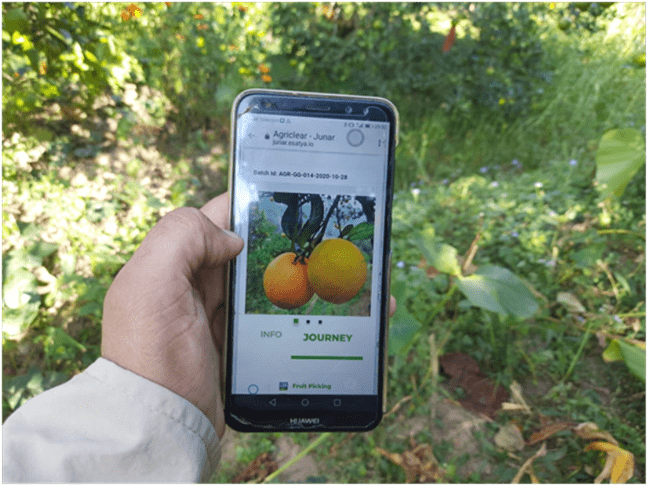Sindhuli Junar Farmers Start Blockchain Food Traceability Trial
4th November 2020, Kathmandu
The Junar ( Sweet Orange ) of Sindhuli from this harvest season will be tracked using a blockchain-based supply chain tracking system, AgriClear. This first pilot project will track the information of Junar from its pluck date to its delivery to customers. It will include information such as origin, cooperative’s name, pluck date, distributor’s name, processing date, food mile, packaging date, and so on. This pilot project will include Junar farms associated with Chisapani Junar Producer Agri. Cooperative, Sindhuli. The farmers and cooperative will record the data of its origin, fruit description, farm name, and pluck date. Green Growth will record the processing date, packaging date, and tag Junars with QR codes. Finally, when consumers buy this QR labeled Junar online through Green Growth, they will be able to see all this information on their mobile phone by simply scanning the QR code that comes with the Junar. This pilot project aims to make the Junar supply chain process transparent and traceable.
eSatya and Green Growth are collaboratively launching the first batch of tracked Junar this festive season. Agricultural Expertise from Junar Super Zone has helped AgriClear in technical aspects whereas Chisapani Cooperative has been providing assistance to connect with the farmers. Likewise, Baato, a cloud-based geospatial service, will be used as our navigation system to measure the food mile of Junar. Foodmile, distance traveled by agro-products before reaching end consumers, is an important metric in agricultural products as it determines the freshness and price of the agro-products.
With the brightest festival Tihar and Chhath around the corner, most of us are planning to celebrate it with big zeal. When it comes to these festivities demand fruits hikes up as we offer them as gifts to our dear ones. Including Citrus rich fruits like Junar in our pile of gifts is a good option amidst this pandemic which helps boost our immunity. But is it possible to buy fresh Junar of Sindhuli staying at home? Are those Junars really from Sindhuli? How can I be sure of it? Wouldn’t it be exciting if one could buy some fresh and local QR labeled Junar from Sindhuli of which they can know how it was harvested, transported, its food mile, and its whole history?
Sweet orange (Citrus sinensis) which is locally known as ‘Junar’ is citrus and highly nutritious fruit rich in vitamins and minerals. It is specially grown in the Sindhuli district of Nepal. Junar produced in Sindhuli has a special identity and is highly valued as “Sindhuli ko Junar” (Junar of Sindhuli) and has high demand across the country. Junar farming in Sindhuli also provides a good source of income to the local farmers.
The current Junar supply chain of Nepal lacks data on demand, supply, how much is produced, where the Junar is supplied to, food mile, where it was stored, who are the middlemen, and so on. Nepalese Junar supply chain is more dependent on personal networking and intuition-based supply chain rather than a rational and statistical supply chain system. Also, the quality issues restrict Nepali fruits to penetrate export markets which could potentially double the benefits to farmers. In 2012 even though China and Nepal signed on a protocol to export citrus fruits in China it couldn’t be able to export due to a lack of quality assurance. The quality issues of the agro-products could be of a lesser problem if we could capture the production data from the field itself and prove the quality of our products with data.
The market value for ‘Sindhuli ko Junar’ is high and has been increasing for a few years, but you can only get information through a vendor as a source to know if it is authentic or not. The absence of data also implies that there is no proof of where the junar is coming from, its quality, freshness, and the actual price. This project thus aims to track the overall history of Junar from its production to supply in blockchain and create tamper-proof data which is beneficial for farmers, cooperatives, distributors, INGO, NGO, developing agencies, and the end-consumers as well. Overall, the authenticity, quality, market trends, and exportability of Junar is created by tracking its history.
We are also planning a second pilot for the Junar Tracking Project for 2021 where the overall information starting from the production phase will be tracked using AgriClear. We will also be analyzing all the challenges and problems faced during the first pilot project and implementing its possible solutions.







